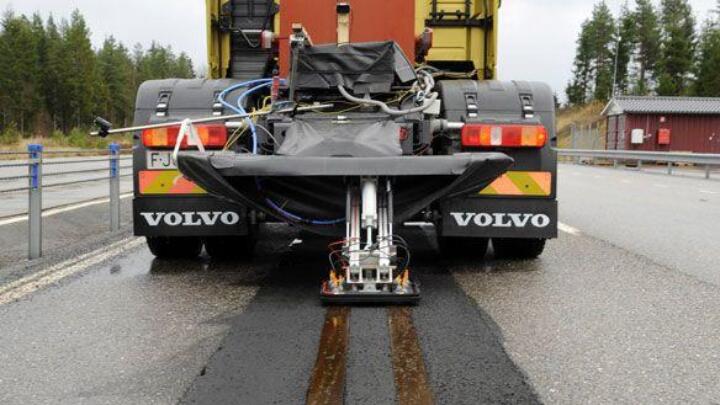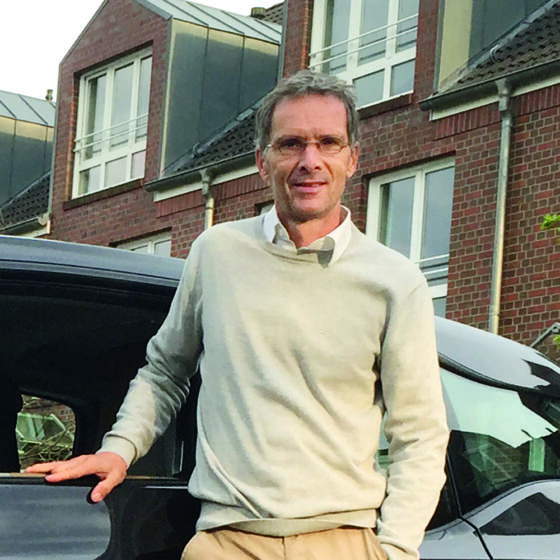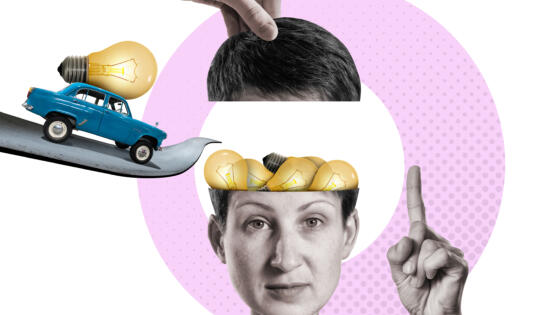
Powerful prospects
Roads are an important piece of the puzzle on the path to mobility for tomorrow – for truck traffic, to name just one example. Nobody in their right mind would think of putting a battery-powered freight or passenger train on a track. Logically, trains are supplied with power from overhead lines – permanently and with high efficiency. So why not “fuel” trucks this way too? It would allow them to travel even long distances on highways quietly and with zero emissions.
A smart name for this already exists. It’s called an eHighway. A real-world route exists as well. In Sweden, north of Stockholm, a pilot project has been underway on a public highway since June 2016. On a dedicated section of the highway, diesel-hybrid trucks can plug into an overhead line and then be operated in fully electric mode. The project is jointly run by Scania and Siemens and could reduce emissions caused by the combustion of fuel by 80 to 90 percent, according to Scania.
Even Chancellor Angela Merkel was impressed by the energy highway during a visit with Swedish Prime Minister Stefan Löfven. The two heads of government agreed to enter into a so-called investment partnership during a meeting in Stockholm. Initially planned in Germany are two test routes, one on A1 between Reinfeld and Lübeck, and the other one between Frankfurt Airport and Darmstadt. “The objective is to make road transportation of goods more climate-friendly in every respect,” says State Secretary Jochen Flasbarth from the German Federal Environmental Ministry.

Local public transportation systems are equally predestined for drawing power from an overhead line. Trolley buses with their current collectors that resemble fishing rods can still be seen in many cities. And every child is familiar with streetcars or trams. They run in Munich and Melbourne as well as in San Francisco or Stuttgart. In many cases, though, such as Hamburg, overzealous politicians in the 70s had rail and overhead power line systems removed in favor of diesel buses. Thinking since then has become more rational again. The city of Hamburg has plans on the shelf for returning to the environmentally friendly streetcar system.
Charge me quickly
As a viable future alternative to the former trolley buses, Siemens has developed the pantograph. This is what the corporation calls its quick-charging system that can be installed on a mast or the canopy of a bus stop shelter. The idea behind the pantograph is to recharge the battery, for instance at a bus terminal, up to a level that allows an electric bus to travel the distance to the next charging station. For fully automatic charging, the bus is driven under a charging station that precisely lowers the pantograph onto the contact rails. Buses providing regular service have been using this system for testing purposes in Dresden since November 2014.
Mobility will continue to evolve from the classic vehicle the way we know it today. Likewise, the road and its direct environment will be seeing a continuing evolution. Overhead lines for trucks or inductive charging while the vehicle is in use are two interesting approaches, as the electric motor has won through in all areas of personal mobility where electrical energy is not being stored but fed to vehicles. Car2X communication with roadside infrastructure is another interesting field for Schaeffler to explore with respect to the utilization of its products. And so are, for example, the fields of Condition Monitoring and Predictive Maintenance in which we are very well positioned in the Industry and Rail sectors
Prof. Peter Gutzmer,
Schaeffler AG’s Chief Technology Officer
Battery-electric buses with additional power supply from an overhead line would provide another advantage, as urban intersections would not have to be completely equipped with overhead lines like in the old days. As a result, there would be no need for complex “cable spaghetti” because the bus can travel the short stretch across the intersection on battery power and subsequently connect itself with the overhead line again.
What works from the top down should also work from the bottom up, similar to a Carrera model race track. This concept, at least, is being investigated by Volvo. Together with rail specialist Alstom, the Swedish truck maker is testing road-integrated power rails on a twelve-kilometer section from Stockholm Airport to the Rosersberg logistics center. “The lines are sectioned so that live current is only delivered to a collector mounted at the rear of, or under, the truck if an appropriate signal is detected,” says Mats Alaküla from Volvo.
Charge me, but don’t touch me
The road no doubt offers further opportunities to supply energy, including wireless ones. For years, induction loops in the surface of streets or roads have been used for switching traffic lights, lifting toll bars or triggering speed cameras. In parking bays, induction loops could be installed underneath the asphalt. Nissan, the world’s major manufacturer of electric cars, even predicts that there will be charging zones in which autonomous vehicles look for induction parking bays themselves, charge their batteries, and subsequently move on to a regular parking space so that others can pull into the charging bay.
Facts and figures
Statically, inductive charging already works today, for instance in Formula E, where the safety vehicles from BMW use “Halo” inductive charging technology from Qualcomm for wireless charging. But what about dynamic charging? Why not use induction to continually supply electric vehicles with power while they are moving? In Israel, start-up ElectRoad is operating a test road for this purpose. A research team at Stanford University in California is working on such an inductive system as well, saying that it would allow clearly smaller and lighter batteries to be installed in the car. Only three percent of the energy transferred by their highway-integrated wireless charging equipment would be lost, according to the researchers. As a positive side effect, autonomous assistance systems could use road-integrated wires for orientation. Technology like this could also be used by companies for on-site transportation and similar purposes as digitalization keeps increasing on the way to Industry 4.0 and smart factories.
Power right from the road
The electric power needed for advanced technologies might be produced by the roads themselves if a project in Tourouvre, France, catches on. There, a 1,000 meter long road section has been paved with solar cells. The electricity they generate (max. 1.500 kWh/767 kWh on average) at least suffices to supply the street lights of the small town with its population of 5,000 with electricity. In the Netherlands and in Germany, similar solutions are in an experimental stage. A major advantage: Space can be used twice. A disadvantage: At the moment, the power from the road is still about 13 times more expensive than the electricity produced by conventional solar power systems. One of the reasons is that the cells are installed flat on the ground and not slanted towards the sun as usual. Therefore, noise barriers equipped with solar panels might be an interesting alternative.
But future roads will not only be a source and dispenser of energy but, equipped with integrated or adjacent sensors, an important source of information for modern traffic control using car-to-infrastructure-communication (Car2X) as well. In March 2017, the German state of Lower Saxony and the German Aeronautics and Space Research Center (DLR) jointly started installing devices on about 280 kilometers of road with which Car2X technologies can be developed further. “Through Car2X, for instance, vehicles receive information about the condition of the road: Is it icy? What places pose a risk of hydroplaning?” explains Prof. Karsten Lemmer, Chair of Energy and Transportation at DLR. “Drivers can adjust their driving style accordingly and future assistance systems can help them do so.”
Designer Daan Roosegaarde has developed his own vision of a “smart highway” – using relatively simple means. For example, the Dutchman would like to spray thermal paints on the road that in freezing temperatures would flash in the form of large ice crystals to warn drivers of black ice, while illuminating paints that store solar energy could make unlit roads brighter.
And what would it be like if there was no need to warn cars of upcoming potholes anymore because they no longer existed? This, for instance, is a vision Henk Jonkers from Delft University of Technology in the Netherlands is working on. Jonkers is a microbiologist and has developed “bio concrete” with self-healing powers. If water enters the concrete structure though a “wound” integrated bacteria will wake up, propagate and help form limestone that closes the “wound.”
No matter what developments we are going to see – in the years ahead, the topic of roads will become more exciting than ever before.






